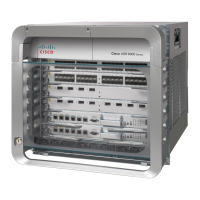163
Cisco ASR 9000 Series Aggregation Services Router Getting Started Guide
OL-28417-02
Chapter
IGMP
Internet Group Management Protocol. Governs the management of multicast groups in a TCP/IP
network. Used by IP hosts to report their multicast group memberships to an adjacent multicast router.
IGP
Interior Gateway Protocol. Internet protocol used to exchange routing information within an
autonomous system. Examples of common Internet IGPs include IGRP, OSPF, and RIP. See also OSPF
and RIP.
ingress
Incoming channel.
installed software
set
The set of Cisco IOS XR software packages installed on a router.
IOS XR
The Cisco operating system used on the ASR 9000 Router, Cisco CRS router and
Cisco
XR 12000 Series Router.
IP
Internet Protocol. Network layer protocol in the TCP/IP stack offering a connectionless internetwork
service. IP provides features for addressing, type-of-service specification, fragmentation and
reassembly, and security.
IPv4
IP Version 4. Network layer for the TCP/IP protocol suite. A connectionless, best-effort packet
switching protocol.
IPv6
IP Version 6. Replacement for IPv4. A next-generation IP protocol. IPv6 is backward compatible with
and designed to fix the shortcomings of IPv4, such as data security and maximum number of user
addresses. IPv6 increases the address space from 32 to 128 bits, providing for an unlimited number of
networks and systems. It also supports quality of service (QoS) parameters for real-time audio and
video.
IPX
Internetwork Packet Exchange. NetWare network layer (Layer 3) protocol used for transferring data
from servers to workstations. IPX is similar to IP and XNS.
IS-IS
Intermediate System-to-Intermediate System. OSI link-state hierarchical routing protocol based on
DECnet Phase V routing, whereby ISs (routers) exchange routing information based on a single metric
to determine network topology.
K
keepalive interval
Period of time between each keepalive message sent by a network device.
keepalive message
Message sent by one network device to inform another network device that the virtual circuit between
the two is still active.
L
Layer 2
Layer 2 refers to the data link layer of the commonly referenced multilayered communication model,
Open Systems Interconnection (OSI). The data link layer contains the address inspected by a bridge or
switch. Layer 2 processing is faster than layer 3 processing, because less analysis of the packet is
required.

